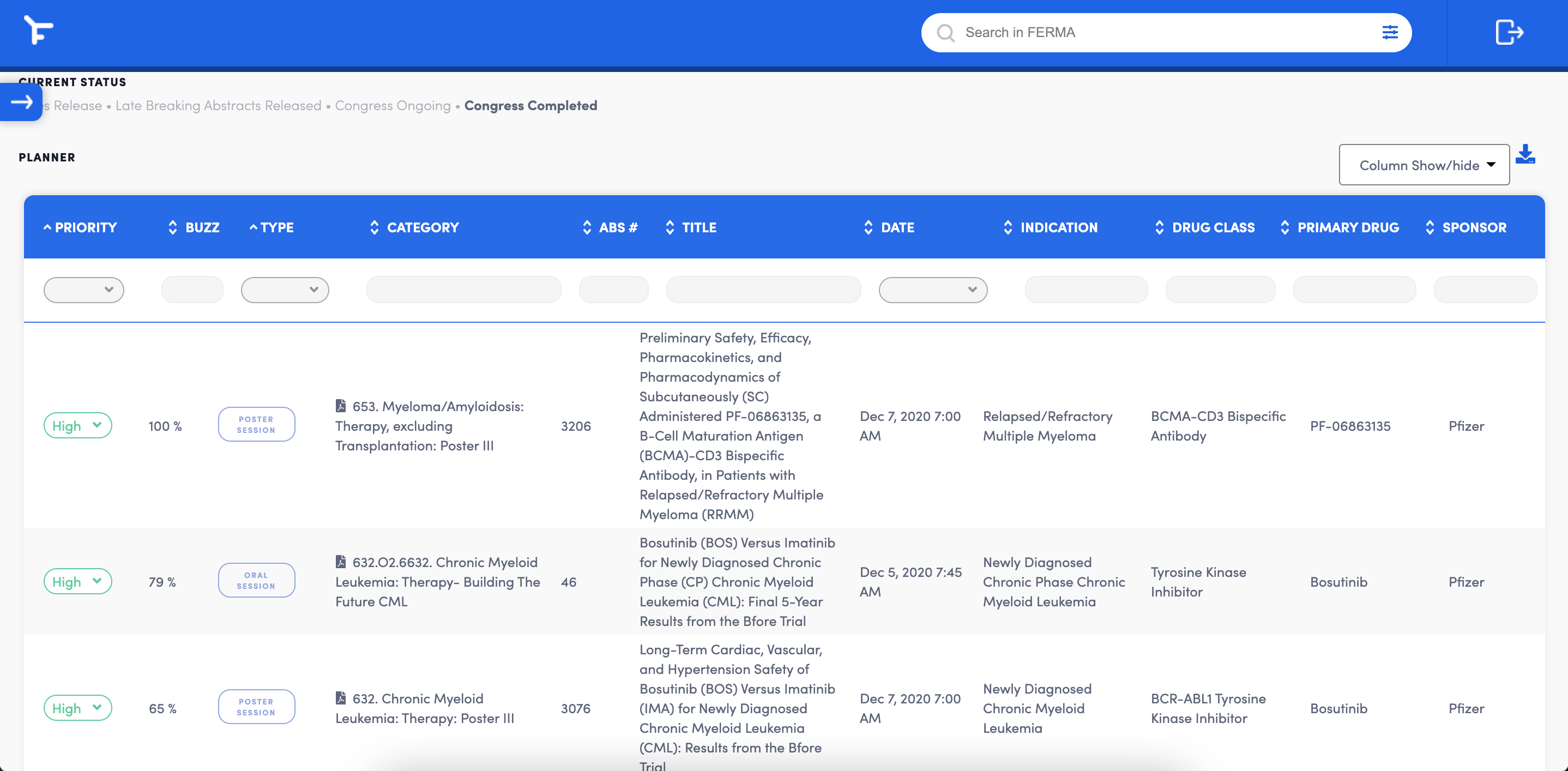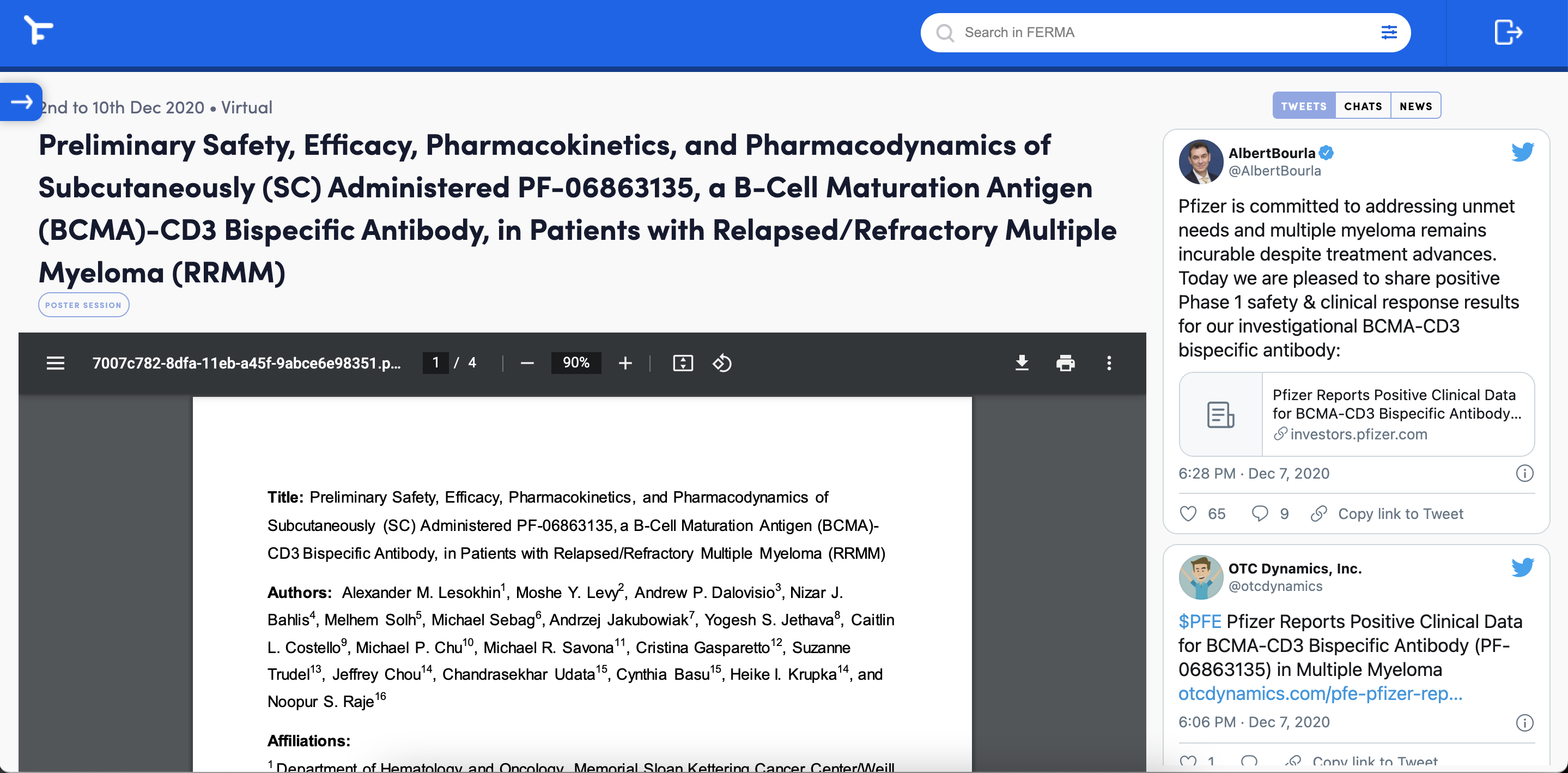Evolving Congress Competitive Intelligence With Artificial Intelligence: Embracing Change and Setting Trends
Jennifer Ghitha, Cheryl Truchana, Zena Askerovaa, Dheepa Charia, Raj Patela and Vivekanandan Mathivananb
a Pfizer Inc., New York, NY, USA
b Ferma.AI, a product of ZoomRx
Explore Abstract

Objective
Determine whether artificial intelligence (AI)-based tools can improve congress competitive intelligence (CI) monitoring and the management of emerging scientific data.
Conclusions

- Leveraging AI for congress CI monitoring enables broader understanding, viewing of data across information sources and more comprehensive insight generation.
- AI efficiently retrieves presentations of interest that can then be utilized for internal reporting. Social media findings can be fully integrated into AI platforms, providing a broader ecosystem of visible information.
- AI is not without limits, and interpretation of data in the context of the landscape still requires subject matter expertise in addition to understanding the use of AI platforms and access to AI.
- Given the breadth of information, AI platforms may need to be supplemented in targeted ways with traditional deliverables (for example, with post-congress reports).
- In order to successfully utilize AI-based platforms for congress CI monitoring, publication professionals need to develop plans for their use over time, including detailed planning for 'packages' of combined pre-, peri- and post-congress deliverables.
Poll
Were you aware of the potential use of AI for CI before reading this poster?
Are you using AI in any other areas of interest to publications professionals?
What are your perceptions about the use of AI for CI after reading this poster?
Did any of the findings from this poster surprise you and why or why not?
Background
There are over 250 medical meetings in oncology every year. In 2020, medical knowledge was predicted to have doubled every 73 days1. The COVID-19 pandemic has accelerated technological advances and posting of data online. Many oncology meetings have converted to virtual formats, as well as improved their online presence. Not only are posters and oral presentations being posted online, they remain available post-congress. Moreover, congresses are also increasingly offering sessions during the periods between their regular meetings. High abstract volume, as well as prominence and numbers of attendees demonstrate that congresses remain a major venue for sharing of the latest scientific data and information.
Companies have traditionally relied upon labour-intensive manual collection and synthesis of large volumes of data and (increasingly present) social media postings from congresses to gather and process competitive data. Individuals and smaller organizations are left to prioritize without these types of resources.
Artificial intelligence (AI), a loosely defined concept describing automated systems that can perform tasks considered to require "intelligence"2 is uniquely suited to mining information from congresses given its abilities to identify, extract and summarize large amounts of data. Several companies are developing AI-based tools to extract information from the literature and congress sites, however these tools are not yet widely adopted.
Methods
- In December 2020, Pfizer Oncology initiated a pilot to discern whether the Ferma.AI platform could improve implementation of CI monitoring at the American Society of Hematology (ASH) annual meeting.
- ASH is an international, large and complex annual meeting focused on hematologic malignancies. ASH 2020, included reports on over 4,000 abstracts, nearly 1,500 oral sessions, over 2,700 poster sessions and 6 late-breaker sessions.
- AI was used to address tasks associated with CI monitoring that had been historically covered via traditional means (Figure 1).
- Tasks executed via AI in ways that were additive to traditional CI monitoring included: identification and retrieval of session data, as well as capturing and ranking impact of social media posts.
FIGURE 1: Difference in Traditional Congress CI vs. AI Based CI Monitoring
| TRADITIONAL CI | AI-BASED CI | EXECUTED IRRESPECTIVE OF METHOD | |
|
Pre-congress abstract prioritization |
|
|
|
Peri-congress CI monitoring |
|
|
|
Post-congress reporting |
|
|
Results
- Data obtained with the platform showed that the number of abstracts and attendees at ASH were similar relative to previous years, despite the evolution to the virtual setting.
- Meta-data from other major Congresses in oncology, suggesting similar trends. These data are not easily obtained via traditional CI monitoring (Figure 2).
FIGURE 2: Congress Statistics: 2018-2020
 Note: ASH 2020 attracted more than 300,000 views with "Fireside Chat with Dr. Anthony Fauci" topping the list with around 10,000 views.
Note: ASH 2020 attracted more than 300,000 views with "Fireside Chat with Dr. Anthony Fauci" topping the list with around 10,000 views.
-
Prioritization of abstracts using AI allowed for more interactive and rapid ranking of sessions as compared with manually executed CI session prioritization.
- 4,182 sessions were evaluated for prioritization and available via a website (Figure 3a) that allowed stakeholders to view and adjust prioritization. 431 sessions were ultimately prioritized.
- Session prioritization dynamics with the AI-based platform allowed the team to cover and archive larger numbers of sessions as compared with traditional means of coverage that are based on available resources and budget for medical writers. For example, in 2019 when traditional coverage was utilized for ASH only 200 sessions were prioritized for coverage.
-
During the congress, individuals were able to access and review content via a central platform while still benefitting from distilled information provided via traditional daily reports (Figure 3b).
- Highly ranked presentations were available for access shortly after they were made available by the congress (typically within 24 hours).
- Social media content was retrieved as it was posted for all presentations.
FIGURE 3a: AI Platform - Session Priorities

FIGURE 3b: AI Platform - Session Overview

- Social media influencers were identified from 33,012 tweets and insights were integrated within the platform. Previously with traditional coverage, social media insights were obtained through a separate vendor and required approximately 2 weeks of wait time for analysis (Figure 4).
- Using AI resulted in cost savings of 40-50% relative to traditional coverage methods executed in partnership with Medical Communications agencies.
FIGURE 4: ASH2020 Twitter Activity By the Numbers*

Demo
Video: AI Platform Walkthrough
Demo: ASH 2020 Congress
Learnings
FIGURE 5: Impact of AI

Conclusions

- Leveraging AI for congress CI monitoring enables a broader understanding of scientific information across an ecosystem of data that are available at large meetings.
- AI efficiently retrieved presentations of interest and performed objective tasks quickly relative to traditional CI collection methods.
- The platform was utilized during the congress and provided users with information on the sessions and transcripts. CI monitoring was connected with social media postings, which helped users understand sentiment.
- To fully optimize CI monitoring, it is necessary to ensure various cross-functional users understand the utility of the platform, proactively identify and address questions the teams may have related to AI in general, as well as educate on platform mechanics.
- Interpretation of the data in the context of the landscape still requires subject matter expertise.
References
- Densen P. Challenges and opportunities facing medical education. Trans Am Clin Climatol Assoc. 2011;122:48-58.
- Chen, J. et al. Current status of artificial intelligence applications in urology and their potential to influence clinical practice. BJU Int. 2019;124:567-577.
